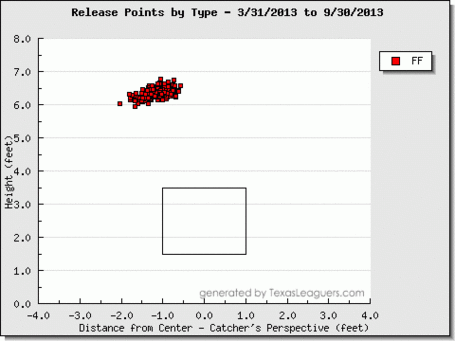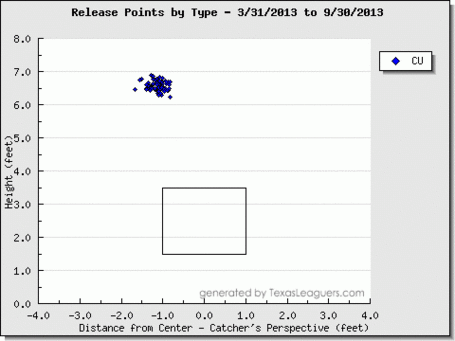
Vic Black has struggled this spring and is by no means a lock to pitch in the Mets' bullpen. What should the team do with the flame-throwing reliever?
For many, Vic Black—the player to be named later acquired in the Marlon Byrd trade last year—was the real gem that the Mets acquired in the trade, at least for the immediate future. Dilson Herrera certainly has a great deal of potential, but as a 20-year-old slated to start the 2014 season in High-A ball, there is no guarantee that he ever becomes a contributing member of the Mets.
Black, on the other hand, was an International League All-Star in 2013 and an Eastern League All-Star in 2012, and he posted a combined 2.03 ERA/2.46 FIP against the upper echelons of the minor leagues, held top prospects and veterans with MLB experience alike to a .176 batting average, and struck out 148 batters in 106.2 innings. As we've seen this spring, that gem has certainly lost its luster.
![]() More Black
More Black ![]()
On the flip side to his exceptional strikeout numbers are Black's subpar walk rates. In 2013, he walked 21 batters in 46.2 innings, a rate of 4.0 walks per nine or 11.1 percent. In 2012, he walked 29 batters in 60 innings, a rate a of 4.4 walks per nine or 11.7 percent. Though he's always had control issues, his ability to strike batters out at a plus rate has masked the problem.
Black's Grapefruit League numbers, while a small sample size and ultimately meaningless in the grand scheme of baseball, have opened peoples' eyes to his flaw. In 2012 and 2013, when he really came into his own, the control problems were easy to ignore because he was still able to put batters away at a plus rate. In his late season cup of coffee with the Mets in 2013, he didn't exhibit any particular control issues in the 13 innings he pitched, so the problem wasn't highlighted.
As Alex Nelson identified last August when the team acquired the reliever, Black's pitching delivery includes a peculiar glove tap. While it serves creates some deception and might give batters momentary pause just like it gives scouts, it often throws off his sense of tempo and momentum, causing the delicate sync between his arm and body to be thrown off. This results in too much or too little on fastballs and breaking balls, release points that are not as tight as they should, illustrated by TexasLeaguers' Pitchf/x tools below, and general wildness.
Black wasn't a complete lock to make the 2014 bullpen coming into spring training, and his performance definitely hasn't helped his case, but on the cusp of his age 26 season, what good would demoting the Texan flamethrower to Triple-A Vegas serve? Black has already shown that he can dominate at that level. Based on his stuff—a power fastball that regularly clocks in a few shades under triple digits with generous sink and a good slider that generates plenty of swings-and-misses—his success there was not a fluke. If demoted, he would likely put up similar numbers to his 2013 season in the International League, perhaps slightly inflated because of the stronger hitting environment in the Pacific Coast League.
The only reason Black should be demoted is if the organization wants the coaches in Las Vegas to tinker with his mechanics to remove the glove tap causing momentum hitches in his delivery. Is that a course of action even worth looking into?
 Photo: David Kohl-USA TODAY Sports
Photo: David Kohl-USA TODAY Sports
Fixing mechanical flaws in a pitcher's delivery is not as simple as identifying and removing them. The unique mechanics that every pitcher uses have been developed over many, many years of playing baseball. Like our everyday mannerisms—our accents, hand gestures while talking, the cadence and pace of how we walk—pitching mechanics are deeply ingrained in pitchers.
While I might be able to purposefully replace my "New York accent" with a "Scouse accent" for a limited time, it would take years and years of speech therapy and training to naturally speak like a Liverpool native. While someone might be able to literally ‘sit on their hands' and prevent themselves from making gestures with their hands while talking, a conscientious effort needs to be made while doing so and any lapse of concentration would result in the old ways being readopted.
The pitching coach simply isn't able to just snap his fingers and have any problems they identify go away. There is no guarantee that changing Vic Black's pitching mechanics will even be for the better. That is, he has come as far as he has with his glove tap and has had the success that he has had with the glove tap, and there is no guarantee that he will be the pitcher that he currently is without it.
Cleveland Indians prospect Trevor Bauer is probably a case study on pitching mechanics. The 23-year-old has had his pitching regimen and mechanics under the microscope for years, and his clashes with GM Kevin Towers and other Arizona Diamondbacks executives regarding them might have been part of the reason he was traded to Cleveland.
In Bauer's own words, a great deal of the struggles he had during 2013 came from "trying to overwrite 10 years of neuromuscular programming in four or five weeks." For the 2012 season, Bauer made 22 starts between Double-A and Triple-A and posted a 2.42 ERA in 130.1 innings. He struck out 157 (10.8 K/() and walked 61 (4.2 BB/9). In 2013, while he was working on altering his mechanics, he made 22 starts in Triple-A and posted a 4.15 ERA in 121.1 innings, struck out 106 (7.9 K/9), and walked 73 (5.4 BB/9).
For what it's worth, Cleveland reporter Dennis Manoloff reported that the Indians and Bauer came up with additional mechanical changes to be integrated into his delivery for the 2014 season, but based on his spring training stats (5 walks and 8 strikeouts in 7 innings), they have yet to curb the issues they are designed to address.
Whether or not the Indians (or the Diamondbacks, for that matter) were right in trying to tinker with the youngsters' mechanics is not for me to judge. Once that path begins, it is a potentially difficult one with many pitfalls. In-game action certainly promotes an environment where a pitcher does not have the ability to sit back and contentiously focus on his mechanics every pitch. From worrying about the batter, the umpire, runners on the basepaths, the weather, the fans, and anything else, a pitcher just isn't afforded the luxury to concentrate on these things like he is during bullpen sessions or other non-game action. As Bauer himself attests to, "when stuff goes awry...it's hard to focus your mechanics, so [you drift] back into old habits."
If Black is sent to Las Vegas to start the season, it should be to remedy his mechanical oddities, and not simply because his numbers have been lacking this spring. As a ‘punishment,' his demotion would not seem to serve any kind of real purpose. It is only if he is sent down as a project will his demotion have any kind of real worth. In addition, the team would have to commit to "staying the course" and cannot be fooled by good or bad numbers over a relative small sample that might suggest one thing or another. Ike Davis, for example, who was demoted midseason in 2013 to Las Vegas to rebuild and overhaul his approach at the plate, returned to the major league club after only 21 games and 92 plate appearances.
Either Vic Black makes the Mets and they make do with the pitcher that he is and has been for some years, or they don't see him for some time while he works out on the kinks that are presumably holding his full potential back.



